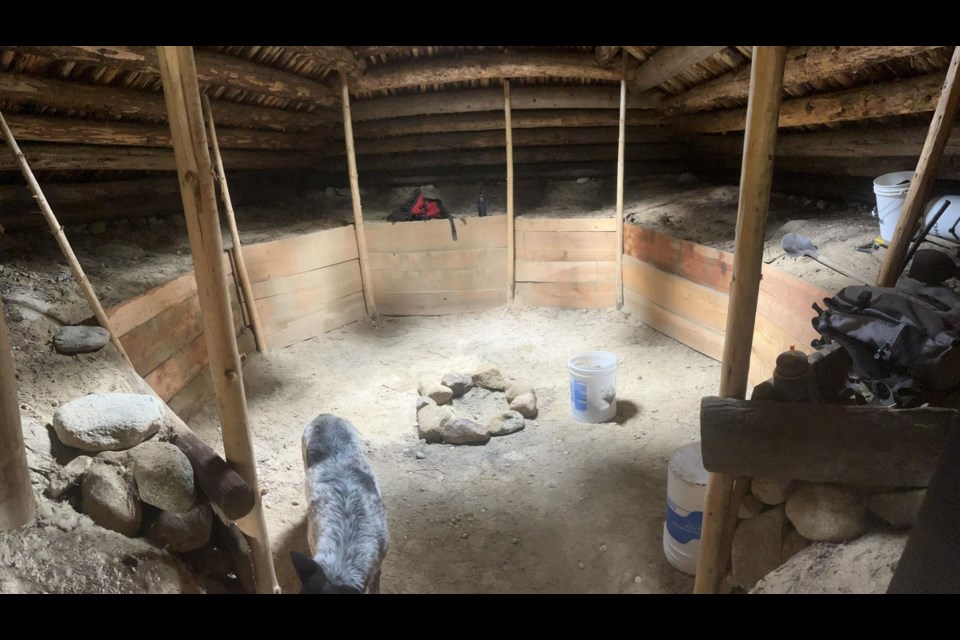“The opening at the top of the larger houses was approximately four feet by six feet, but the rain and snow never went inside because the fire was directly below. In the meadow, the housepits were quite shallow to avoid hitting water. Once the pit was dug, logs were laid horizontally across the ground, surrounding the four sides of the hole. At each end of the logs, a notch was burnt in, using hot rocks, so that the next log would fit snugly into place. More logs were placed on top and eventually the top became smaller, as shorter logs were used. The smoke-hole was also the entrance. At the highest point, the winter house was between eight and nine feet above ground. Then cedar planks were cut or split from wind-falls and placed over the logs. The cracks were filled with cedar bark, and the house was covered with dirt.”
That was Charlie Mack’s description of the pit-house (istken) he built, as captured in the 2010 book, . Born in 1899, Mack was a talented Lil’wat storyteller, an experienced trapper, and a man determined to share the knowledge he had gathered in his lifetime.
Decades after his death, an 18-year-old Lil’wat man from Mount Currie decided to build his own pithouse based on Mack’s short description. An archaeology student at Simon Fraser University, Talon Pascal has been interested in the ancient past from a young age.
“Unlike a lot of people the same age as me, I actually knew what I wanted to do from a really young age,” said Pascal. “I’m glad because it made everything easier. I knew what to prepare for. I knew what I had to do going into it. My main goal was to study prehistory, so before the creation of nations, before the rise of really big civilizations.”
Pascal and his brother recently skied down Ts'zil, known by settlers as Mount Currie, a journey that was captured in the new documentary film, Slides on the Mountain.
When Pascal decided to build a pithouse, it was difficult to find literature on the subject, apart from Mack’s brief passage. “When we first had the idea to build it, it was just me and my high school buddies,” he said. “We were hiking up one of our favourite trails and there’s a really nice flat spot there. My dad was always saying that it would be a good place to build a cabin. I wanted to build a pithouse. We started it years ago, but it was really hard because we were in high school and all my buddies had jobs. It was kind of on and off.”
Luckily, Pascal was able to quickly put together the pieces in his head and imagine the finished product. ”The main goal was to get a pithouse done in the traditional style that the people here used to do,” he said. “The main inspiration was from the little paragraph in the Charlie Mack book. He was able to explain it in such nice detail with so little words. I can read something and then put it together in my head, the way it would work. When I read that paragraph, I was able to put together in my head how it would look when it was done.”
The work of James Teit also helped the young man on his quest for answers. A settler from Scotland’s Shetland Islands, Teit spent time in Spences Bridge, B.C., northeast of Lytton, and became immersed in traditions, including pithouse building.
“He was a late 18th-, early 19th-century ethnographer. He had this whole ethnography written out about almost every aspect of the … lifestyle and how they lived,” Pascal said.
Balancing the build with other commitments was a tricky task. Pascal now hopes to use the completed pithouse as a hunting cabin. “Within this last year, I’ve really been trying to put my time into it. I managed to finish it before I went off to university. We would just put it up on Instagram and lots of people would come out to help. Me and my cousin slept in there one weekend,” he said.
Pascal understands the vital importance of sharing and possessing these time-honoured skills to his community, just like Charlie Mack before him.
“Someone going out and building a pithouse is not something you see every day.We live in modern houses now. We live in apartments, and we have jobs so it’s not necessary. But I still think it’s important because it’s still part of our culture. You get people who still carve totem poles. You get basket makers. I think building a pit-house is the same thing on a much bigger scale,” he said.
“It’s something that still needs to be kept alive. I know a handful of people in Mount Currie who still do the bow making, but then again, it’s only a handful of people. I definitely think it’s part of my responsibility to teach others.”



